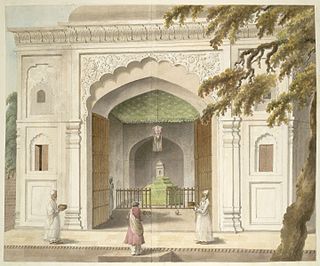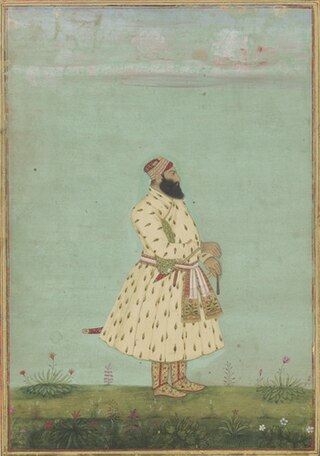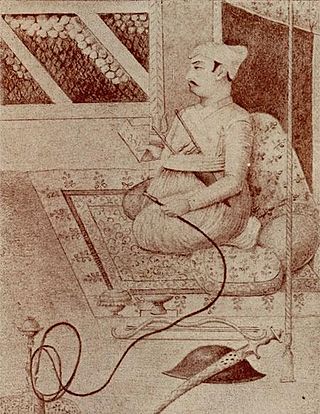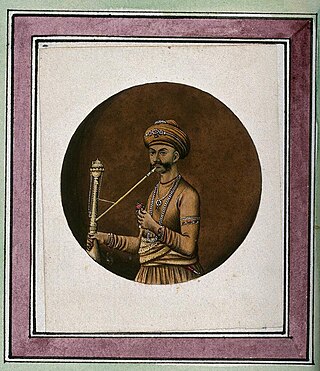Related Research Articles

Awadh, known in British historical texts as Avadh or Oudh, is a historical region in northern India, now constituting the northeastern portion of Uttar Pradesh. It is roughly synonymous with the ancient Kosala region of Hindu, Buddhist, and Jain scriptures.
Nawab is a royal title indicating a ruler, often of a South Asian state, in many ways comparable to the western title of Prince. The relationship of a Nawab to the Emperor of India has been compared to that of the Kings of Saxony to the German Emperor. In earlier times the title was ratified and bestowed by the reigning Mughal emperor to semi-autonomous Muslim rulers of subdivisions or princely states in the Indian subcontinent loyal to the Mughal Empire, for example the Nawabs of Bengal.

Rohilkhand is a region in the northwestern part of Uttar Pradesh, India, that is centered on the Bareilly and Moradabad divisions. It is part of the upper Ganges Plain, and is named after the Rohilla. The region was called Madhyadesh and Panchala in the Sanskrit epics Mahabharata and Ramayana. During the colonial era in India, the region was governed by the Royal House of Rampur.

Shuja-ud-Daula was the third Nawab of Oudh and the Vizier of Delhi from 5 October 1754 to 26 January 1775.

Wazir-ul-Mamalik-e-Hindustan Asaf Jah Jamat-ul-Mulk Shuja-ud-Daula Nawab Abul Mansur Khan Bahadur Safdar Jang Sipah Salar, better known as Safdar Jang, was the second Nawab of Kingdom of Awadh succeeding Saadat Ali Khan I in the year 1739. All future Nawabs of Awadh were patriarchal descendants of Safdar Jang. He was a major political figure at the imperial Mughal court during the declining years of the Mughal Empire.

Rohillas are a community of Pashtun heritage, historically found in Rohilkhand, a region in the state of Uttar Pradesh, India. It forms the largest Pashtun diaspora community in India, and has given its name to the Rohilkhand region. The Rohilla military chiefs settled in this region of northern India in the 1720s, the first of whom was Ali Mohammed Khan.

Ahmad Shah Bahadur, also known as Mirza Ahmad Shah or Mujahid-ud-Din Ahmad Shah Ghazi, was the fourteenth Mughal emperor, born to Emperor Muhammad Shah. He succeeded his father to the throne in 1748, at the age of 22. When Ahmed Shah Bahadur came to power, the Mughal Empire started to decline. Furthermore, his administrative weakness eventually led to the rise of the usurping Imad-ul-Mulk.

Shah Alam II, also known by his birth name Ali Gohar, or Ali Gauhar, was the seventeenth Mughal emperor and the son of Alamgir II. Shah Alam II became the emperor of a crumbling Mughal Empire. His power was so depleted during his reign that it led to a saying in the Persian language, Sultanat-e-Shah Alam, Az Dilli ta Palam, meaning, 'The empire of Shah Alam is from Delhi to Palam', Palam being a suburb of Delhi.

The Battle of Buxar was fought between 22 and 23 October 1764, between the forces of the British East India Company, under the command of Major Hector Munro, and the combined armies of Balwant Singh, Maharaja of the Banaras State; Mir Qasim, Nawab of Bengal; Shuja-ud-Daula, Nawab of Awadh; and Shah Alam II, Emperor of the Mughal Empire.

Mir Syed Jafar Ali Khan Bahadur, more commonly known as just Mir Jafar, was a commander-in-chief or military general who reigned as the first dependent Nawab of Bengal of the British East India Company. His reign has been considered by many historians as the start of the expansion of British control of the Indian subcontinent in Indian history and a key step in the eventual British domination of vast areas of pre-partition India.

Mir Qasim was the Nawab of Bengal from 1760 to 1763. He was installed as Nawab with the support of the British East India Company, replacing Mir Jafar, his father-in-law, who had himself been supported earlier by the East India Company after his role in winning the Battle of Plassey for the British. However, Mir Jafar eventually ran into disputes with the East India Company and attempted to form an alliance with the Dutch East India Company instead. The British eventually defeated the Dutch at Chinsura and overthrew Mir Jafar, replacing him with Mir Qasim. Qasim too later fell out with the British and fought against them at Buxar. His defeat has been suggested as a key reason in the British becoming the dominant power in large parts of North and East India.

Najib ad-Dawlah, also known as Najib Khan Yousafzai, was a Rohilla Yousafzai Afghan who earlier served as a Mughal serviceman but later deserted the cause of the Mughals and joined Ahmad Shah Abdali in 1757 in his attack on Delhi. He was also a House Chief of Rohilkhand, and in the 1740s founded the city of Najibabad in Bijnor, India. He was instrumental in winning the Third Battle of Panipat.

The Nawab of Awadh or Nawab of Oudh was the title of the rulers of Kingdom of Awadh in northern India during the 18th and 19th centuries. The Nawabs of Awadh belonged to an Iranian dynasty of Sayyid origin from Nishapur, Iran. In 1724, Nawab Sa'adat Khan established the Kingdom of Awadh with their capital in Faizabad and Lucknow.

Yameen-ud Daula Saadat Ali Khan II Bahadur was the sixth Nawab of Oudh from 21 January 1798 to 11 July 1814, and the son of Shuja-ud-Daula. He was of Persian origin.

Feroze Jung III or Nizam Shahabuddin Muhammad Feroz Khan Siddiqi Bayafandi also known by his sobriquet Imad-ul-Mulk, was the grand vizier of the Mughal Empire when it was under Maratha suzerainty, making them the de facto rulers.

Local tradition holds Fyzabad or now Faizabad is identical with Saketa of the Ramayana, supposedly the private estate of King Dasharatha, the father of Rama. It is claimed that Saket was renamed after the death of Faiz Baksh, a courtier of the Nawab of Awadh. Historically, when Nawab Saadat Ali Khan, Burhan-ul-Mulk was given the charge of the Subah of Awadh around 1722 by the Mughal court, he settled on the banks of the river Ghaghara, building a fortress and mud barracks. Due to these temporary dwellings, the settlement was initially referred to as 'Bangla'.

The Oudh State was a Mughal subah, then an independent kingdom, and lastly a princely state in the Awadh region of North India until its annexation by the British in 1856. The name Oudh, now obsolete, was once the anglicized name of the state, also written historically as Oudhe.

Muhammad Ahmad Khan Bahadur Ghalib Jang or Ahmad Khan Bangash was a Mughal nobleman and Nawab of Farrukhabad from the Rohilla Afghan Bangash dynasty. He was the second son of Muhammad Khan Bangash, a powerful Mughal nobleman. He took part in the Third Battle of Panipat in 1761 against the Marathas led by Sadashivrao Bhau.

Nawab Diler Himmat Khan, commonly known by his regnal name Muzaffar Jang (1771–1796) was the fourth Nawab or ruler of Farrukhabad, a kingdom in Medieval India. He succeeded his father Ahmad Khan Bangash as the ruler in 1771.
References
- 1 2 Srivastava, Ashirbadi Lal (1939). "Rise and Fall of Maharajah Beni Bahadur, 1759-1767". Proceedings of the Indian History Congress. 3: 1034–1042. ISSN 2249-1937. JSTOR 44252450.
- 1 2 Syed Ghulam Ali Khan. Imad-us-saadat [Pillar of Saadat] (in Persian). p. 80.
- ↑ Graff, Violette, ed. (1997). Lucknow: memories of a city. Delhi: Oxford University Press. p. 28. ISBN 978-0-19-563790-8.
- ↑ Singh, Kalyan. Khulasat-ut-tawarikh[Epitome of History] (in Persian). pp. 123 b.
- 1 2 Das, Hari Charan. Chahar-i Gulzar-i Shujai [Abundant Garden of Shuja]. Translated by Elliot, Henry Miers. pp. 470 a. doi:10.1017/CBO9781139507219.035.
- ↑ Syed Ghulam Ali Khan. Imad-us-saadat (in Persian). p. 81.
- ↑ Bilgrami, Sayyid Muhammad Hussaini Vasiti (1768). Tabsirat-un-Nazirin (Tabsir)[A Rendering of the Protector] (in Persian). p. 675.
- ↑ Rizavī, Saiyada Najamula Razā (2004). Zamindars and Revenue Farmers of Eastern Uttar Pradesh: From Mughal to Colonial Rule. New Delhi: Anamika Publishers and Distributors. p. 137. ISBN 978-81-7975-053-7.
- ↑ Illāhābādī, Fakir Maulvi Khair ud-Dīn Muḥammad (1875). The Bulwuntnamah: Translated from the Tuhfa-i-taza of Fakir Khair-ud-Din Khan (1780). Translated by Curwen, Frederick. Allahabad: North-Western Provinces Government Press. pp. 45–46.
- 1 2 3 Srivastava, Ashirbadi Lal (1939). Shuja Ud Daulah Vol I (1st ed.). Calcutta: S N Sarkar. pp. 69–297.
- ↑ Rajwade, Vishwanath Kashinath (ed.). "खंड तिसरा (१७०० - १७६०) Volume 3 (1700 - 1760)". samagrarajwade.com (in Marathi). Letter nos. 511, 512. Retrieved 12 August 2023.
- ↑ Bilgrāmī, Murtaz̤á Ḥusayn Khan (1879). Ḥadīqat al-aqālīm [Treatise on the Kingdoms]. Lucknow: Munshī Naval Kishor. p. 674.
- 1 2 Various authors. Sardesai, Govind Sakharam (ed.). Peshwa Daftar Volume 29: Affairs of Northern India: Peshwa Madhav Rao I (in Marathi). Bombay: Government Central Press. pp. 4127, 4167.
- ↑ Ross, E. Dennison, ed. (January 1911). Calendar Of Persian Correspondence Vol. 1 (1759-1767). Calcutta: Superintendent of Government Printing. Letter no. 2065.
- ↑ Barbé, Émile (1894). Le Nabab René Madec, Histoire diplomatique des projects de la France sur le Bangale et le Pendjab (1772-1808) [The Nawab René Madec, A Diplomatic History of France's Projects in Bengal and Punjab (1772-1808)] (in French). Paris: Felix Alcan. pp. 28–29.
- ↑ Innes, Percival Robert (1885). The History of the Bengal European Regiment: Now the Royal Munster Fusiliers, and how it Helped to Win India. London: Simpkin, Marshall and Company. p. 191.
- ↑ Muhammad Ali Khan Ansari (1800). Tarikh-i Muzaffari [History of Muzaffar's Rule] (in Persian). pp. 2438–2448.
- ↑ Munshi Munna Lal (1811). Shah Alam Nama / Tarikh Shah Alam[History of Shah Alam's Rule]. Khuda Bakhsh Oriental Library. p. 76.
- 1 2 Khan Tabataba'i, Seid Gholam Hossein ibn Hidayat Allah (1780). The Seir Mutaqherin Vol. 2. Translated by Monsieur Raymond aka Haji Mustafa aka Nota Manus (Reprint ed.). Delhi: Low Price Publications (published 1990). pp. 762–764. ISBN 8185395632.
- ↑ Ross, E. Dennison, ed. (January 1911). Calendar Of Persian Correspondence Vol. 1 (1759-1767). Calcutta: Superintendent of Government Printing. Letter no. 2475A.
- ↑ Bengal Secret Consultations. Vol. III. London: India Office Library. pp. 273, 284–86, 298.
- ↑ Muhammad Ali Khan Ansari (1800). Tarikh-i Muzaffari (in Persian). British Museum Manuscripts. pp. 252b.
- 1 2 Illahabadi, Fakir Maulvi Khair-ud-din Muhammad (1806). Ibrat Namah[Advisory Treatise] (in Persian). pp. 172–174.
- ↑ Nevill, H. R. (1905). Sitapur: A Gazetteer, Being Volume Xl Of The District Gazetteers Of The United Provinces Of Agra And Oudh. Allahabad: Government Press. pp. 188–191.
- 1 2 Ashirbadi Lal Srivastava (1945). Shuja-ud-daulah Volume II 1765-1775. Lahore: Minerva Book Shop. pp. 57, 332–334.